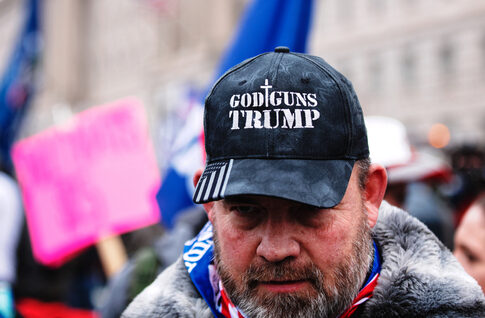The Trump administration is ending Biden’s “zero tolerance” policy for gun dealers who violate federal regulations. Plans include reassessing bans on pistol braces and background checks for private gun sales. Trump promised NRA members that he would protect the Second Amendment during his second term. Legal experts point out that completely reversing Biden’s gun policies faces procedural hurdles and potential court challenges.
The Justice Department begins dismantling Biden-era gun regulations
The Trump administration has begun rolling back gun control measures implemented during President Biden’s term, with Attorney General Pam Bondi leading the charge to eliminate the “zero tolerance” approach toward firearm dealers who commit federal violations. This policy shift represents the first in what is expected to be a series of reversals of Biden-era gun regulations, fulfilling campaign promises Trump made to gun rights supporters during the 2024 election cycle. The administration has indicated that regulations on pistol braces and expanded background check requirements are also under review for potential repeal.
Trump’s approach to gun policy was outlined in a recent executive order titled “Protecting Second Amendment Rights,” which directs the Attorney General to review ongoing and potential litigation affecting gun ownership rights. The administration has signaled its intention to defend gun ownership more aggressively than its predecessor, particularly by challenging restrictions that it believes infringe on constitutional rights. Gun rights organizations have celebrated these early moves as delivering on Trump’s promises to firearm owners.
JUST IN: Trump Dismantles Biden’s Gun Control Actions, Signs Executive Order to Protect Gun Owners
READ: https://t.co/WztX1bMS3s pic.twitter.com/HdHZUtHknx
— The Gateway Pundit (@gatewaypundit) February 8, 2025
Challenges to Fully Reversing Biden’s Gun Policies
Despite Trump’s promises to swiftly undo Biden’s gun regulations, legal experts note that the process faces significant hurdles. Repealing formal rules requires following the Administrative Procedures Act, which mandates the same lengthy process used to create regulations. This means full reversals of policies like ghost gun restrictions and pistol brace regulations could take months or years and would likely face legal challenges from gun safety advocates. The administration must provide substantive justification for any regulatory changes to withstand judicial scrutiny.
“The APA’s rulemaking requirements generally apply to the repeal and amendment of rules, as well as to their initial issuance.” – a 2021 report from the Congressional Research Service
Trump’s approach to gun policy is likely to focus on areas where executive authority is strongest. This includes appointing a new ATF director to replace Steve Dettelbach, changing enforcement priorities, and altering the Justice Department’s positions in pending lawsuits challenging Biden’s gun regulations. These actions could substantially change the federal government’s approach to firearms regulation even before formal rules are rescinded. Personnel changes within agencies that oversee gun regulations may prove to be the most immediate and consequential changes.
NEW @thenatpulse: Trump DOJ, ATF Roll Back Biden's 'Zero Tolerance' Gun Policy.
PULSE POINTS:
❓What Happened: The Depar……READ ON:https://t.co/agSUUaBO19
— Raheem. (@RaheemKassam) April 8, 2025
Reaction from Gun Rights Supporters and Safety Advocates
The Trump administration’s moves have drawn sharply divided reactions. Gun rights organizations have praised the early actions as fulfilling campaign promises and protecting constitutional rights. The National Rifle Association, which endorsed Trump, views these changes as a victory after facing challenges from Biden’s regulations. Gun dealers in particular have welcomed the end of the “zero tolerance” policy, which they described as overly punitive for minor paperwork violations and technicalities that threatened their businesses.
“During my four years, nothing happened. And there was great pressure on me having to do with guns. We did nothing. We didn’t yield.” – Donald Trump
Gun violence prevention groups, however, have expressed alarm at the rollbacks. Organizations like Brady and Giffords have pledged to intensify their advocacy efforts, arguing that looser regulations will increase gun violence. These groups point to data showing firearms as a leading cause of death for young Americans and public opinion polls indicating majority support for stricter gun laws. The policy reversal occurs against a backdrop of continuing debate about the relationship between regulations and public safety, with advocates on both sides citing different studies to support their positions.
Broader Implications for Gun Policy
The Trump administration’s actions on gun regulations will likely have ramifications beyond specific rules being repealed. The Justice Department is expected to change course in major Second Amendment cases currently working through federal courts. This shift could affect litigation involving handgun sales to people under 21, possession restrictions for non-violent offenders, and other contested areas of firearms law. With three Trump-appointed justices on the Supreme Court who have shown support for broad Second Amendment protections, the legal landscape for gun rights appears increasingly favorable for firearms advocates.
The administration is also expected to support legislation expanding concealed carry reciprocity across state lines and enhancing school security measures, including allowing trained teachers to carry concealed weapons. These proposals face uncertain prospects in Congress but demonstrate the administration’s broader agenda on firearms. As these policy changes unfold, both supporters and critics are closely monitoring their implementation and potential effects on gun ownership, commerce, and safety across the country.


